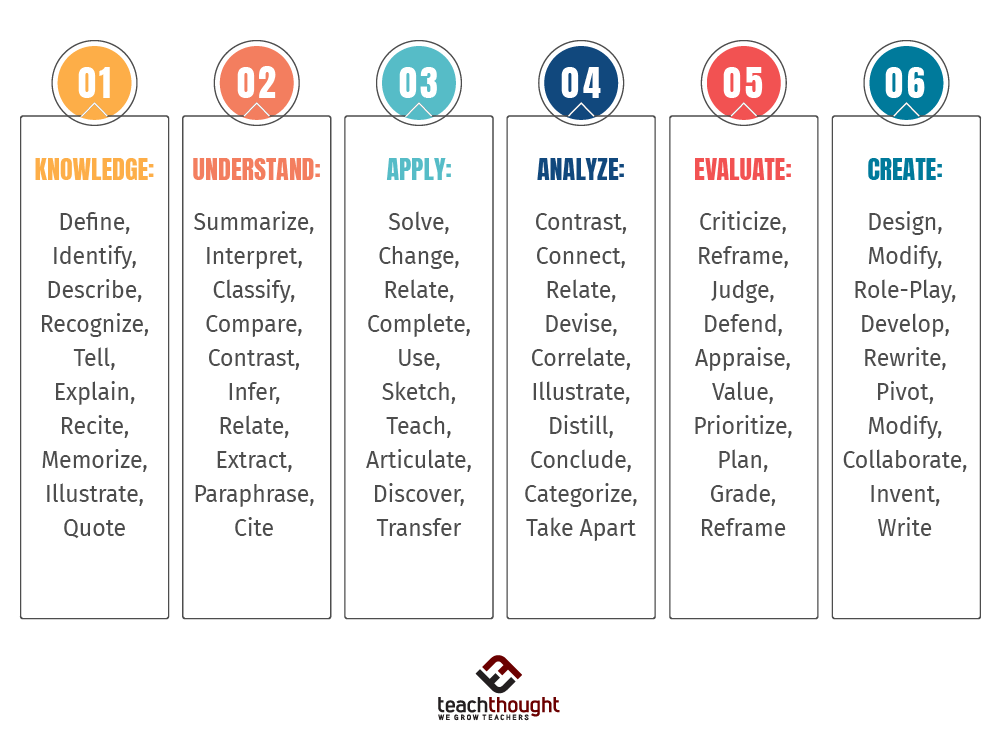
by Staff
The verbs of Bloom taxonomy – also known as power verbs or reflection verbs – are extraordinarily powerful educational planning tools.
In fact, in addition to concepts such as backward design and energy standards, they are one of the most useful tools to which a teacher as a teacher designer has access. For what?
As research has suggested, they can be used for assessment design, curriculum design, lesson planning, personalization and differentiate learningAnd almost any other “thing” a teacher – or a student – has to do.
For example, if a standard asks students to deduce and demonstrate the position of an author using evidence of the text, there are a lot of things in this type of task. First, a student must be able to define what an “position of an author” is and what “the evidence of the text” means (In terms of knowledge). They must then be able to summarize this same text (Understanding), interpret and deduce any argument or position (Analyze the level), assess the inherent claims (Assess the level), then write (Level of creation) An answer that demonstrates their thought.
Although the graph below can be read from left to right, it is ideal to imagine it as a kind of inclination, with knowledge at the bottom, and to create at the top. You may not always need this type of tool to “unpack” standards and identify a possible learning sequence, but it also works ideally as an evaluation design tool. If students can consider with the subject of the columns on the right – design, recommend, differentiate, compare and contrast, etc., they probably have a good understanding of the material.
You can also find out more about Revised taxonomy of Bloom (or the bloom update taxonomy) if you are so inclined.
While we shared Bloom taxonomy posters Before, the simplicity and clean design of the graph format make it a little more functional – even useful to put the students themselves as a punch and caretaker resource in the day for the type of year. It also makes a powerful autodirigated learning tool. Start left and, roughly, move to the right.
Also see Bloom’s digital verbs for teaching -rich teaching for a version of Bloom’s designed for tasks and digital tools.
For a visual version of this frame, see Bloom’s digital taxonomy table.
Knowledge: Defining, identifying, describing, recognizing, saying, explaining, reciting, memorizing, illustrating, quote, state, correspond, recognize, select, examine, locate, recite, list, record, list, cite, label
Understanding: summarizing, interpreting, classifying, comparing, contrasting, infer, connect, extract, paraphrase, quote, discuss, distinguish, delimit, extend, predict, indicate, translate, investigate, associate, explore convert
Apply: solve, change, connect, complete, use, sketch, teach, articulate, discover, transfer, show, demonstrate, implicate, dramatize, produce, signal, act, administer, act, prepare, manipulate, manipulate, manipulate, manipulate, manipulate, manipulate
Analyze: contrast, connect, link, design, correlate, illustrate, distill, conclude, categorize, dismantle, solve the problem, differentiate, deduce, conclude, design, subdivide, calculate, order, adapt, adapt
Evaluate: criticize, crop, judge, defend, assess, value, prioritize the plan, note, crop, revise, refine, note, argue, support, evolve, decide, give back, pivot
Create: design, modify, play role, develop, rewrite, pivot, modify, collaborate, invent, write, formulate, invent, imagine
100+ Bloom taxonomy verbs for critical thinking
Teachthought’s mission is to promote critical thinking and innovation education.



